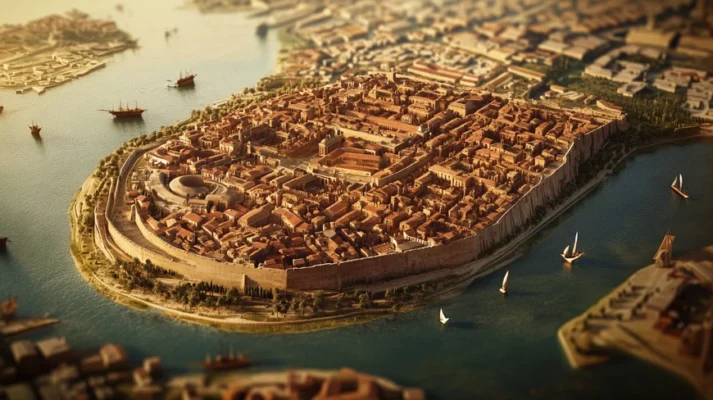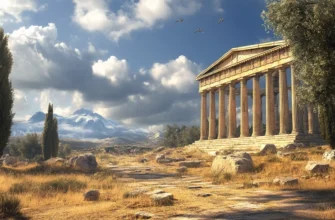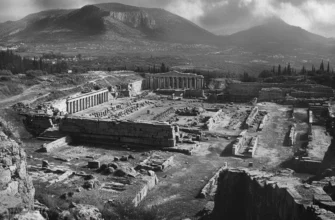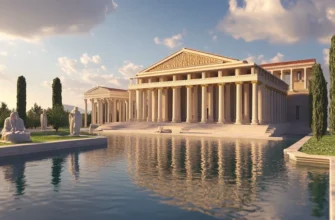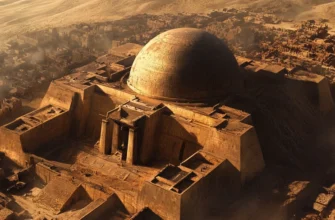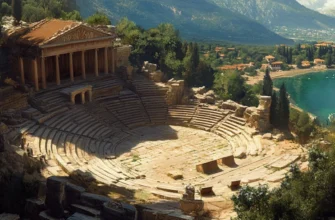Syracuse was one of the most powerful cities in ancient Greece, founded in the 8th century BC by Greek colonists from Corinth on the island of Sicily. Thanks to its favorable location on the Mediterranean coast, the city quickly became an important commercial, political, and cultural center of the region.
In classical times, Syracuse was famous for its military power, fleet, and fortifications. It was ruled by tyrants, including Dionysius the Elder, who turned the city into one of the strongest states in western Greece. During his reign, Syracuse fought actively against Carthage for dominance in the Mediterranean.
The city also became a center of science and art. It was in Syracuse that the outstanding scientist Archimedes was born and worked, whose legacy influenced the development of physics and mathematics.
In 212 BC, Syracuse was conquered by Rome during the Second Punic War. Despite its defeat, the city retained its cultural importance and left behind a rich archaeological heritage that still attracts researchers and tourists today.
Syracuse is a striking example of the fusion of Greek culture with the western Mediterranean and remains a symbol of the ancient glory of the Hellenic world.
Foundation of the city
Syracuse was founded in 734 or 733 BC by Greeks from the city of Corinth. The colonists, led by Archias, the legendary leader of the expedition, landed on the eastern coast of Sicily, in a place previously inhabited by the Sicani, the indigenous population.
The location for the settlement was extremely well chosen: the island of Ortigia, a convenient harbor, and fertile land contributed to the rapid development of the city. Soon, Syracuse became an important trading center and began to expand its influence over the surrounding lands, founding new settlements and fortifications.
The colonization of Sicily by Syracuse marked the beginning of its rise, which eventually made the city one of the most famous and powerful centers of Western Greece.
During the classical era (5th–4th centuries BC), Syracuse experienced a period of prosperity, becoming one of the most influential states in the Greek world. Thanks to its strong navy, strategic location, and active foreign policy, the city controlled a significant part of Sicily and even rivaled Athens.
The period of the tyrants was particularly significant, especially Dionysius the Elder, who turned Syracuse into a powerful military state. At this time, the city successfully resisted the threat from Carthage, built fortresses and fortifications, and developed its fleet.
Cultural life also flourished: playwrights and philosophers performed in Syracuse, and architects and sculptors worked there. The city became a center of science, where Archimedes later lived and worked.
Thanks to its economic prosperity, political stability, and military strength, Syracuse established itself as the main center of Greece in the western Mediterranean.
The period of the tyrants
In the 5th–4th centuries BC, Syracuse was ruled by tyrants — powerful autocrats who concentrated military, political, and economic power in their hands. This period played a decisive role in shaping the city’s power.
Dionysius the Elder
The most famous of the tyrants was Dionysius the Elder (405–367 BC). He came to power during a threat from Carthage and quickly consolidated his position, turning Syracuse into a powerful fortress. He modernized the army, expanded the navy, and built large-scale fortifications, including the famous “Wall of Dionysius,” which protected the city. During his reign, Syracuse became the main military power in the Western Mediterranean.
Dionysius the Younger
After the death of Dionysius the Elder, power was inherited by Dionysius the Younger, a less experienced politician whose reign was accompanied by internal conflicts and power struggles. His attempts to preserve tyranny were met with resistance from the philosopher Dion, a student of Plato, who sought to establish a republican system. Plato’s intervention in the political life of Syracuse left its mark on the history of philosophy, but did not change the fate of the city.
The period of the tyrants left behind a controversial legacy: on the one hand, centralized power and military might, and on the other, constant internal crises and despotism.
Philosophers and scientists of Syracuse
Syracuse became an important center of intellectual life in the Western Mediterranean. The city was home to prominent philosophers and scientists whose work had a profound influence on the development of science, technology, and philosophy.
Archimedes and his contribution
The most famous scientist of Syracuse was Archimedes (c. 287–212 BC), a brilliant mathematician, physicist, and inventor. He made fundamental discoveries in geometry, mechanics, and hydrostatics. Archimedes formulated the principle of buoyancy, known as Archimedes’ principle, developed systems of levers and blocks, and invented numerous engineering devices, including screws for lifting water.
During the siege of Syracuse by the Romans, Archimedes created defensive mechanisms that significantly delayed the capture of the city. Despite the Roman commander’s order not to kill Archimedes, he was killed during the capture of the city in 212 BC.
Plato and political experiments
The famous Athenian philosopher Plato visited Syracuse three times in an attempt to implement his political ideals. He hoped to convince the tyrants, in particular Dionysius the Younger, to introduce just rule based on the principles of philosophical reason. Plato was supported by his student Dion, but the attempt at reform failed due to political instability and hostility from the tyrant’s entourage.
Despite the failure, Plato’s experience in Syracuse became an important chapter in the history of political philosophy, as he tested his theoretical concepts from “The Republic” in practice.
Archimedes of Syracuse (c. 287–212 BC) was one of the most outstanding scientists of the ancient world. He was born and spent most of his life in Syracuse, where he gained recognition as a brilliant mathematician, physicist, astronomer, engineer, and inventor. His works were far ahead of their time and became the basis for the further development of the natural sciences.
Archimedes’ most famous discovery is the law of hydrostatics, or Archimedes’ principle, according to which a body immersed in a fluid experiences an upward force equal to the weight of the fluid displaced by the body. According to legend, Archimedes discovered this principle in a bath, shouting “Eureka!” and running out into the street.
Archimedes made an enormous contribution to mathematics: he developed methods for calculating the areas and volumes of complex figures, approximating the number π, and studying parabolas, spirals, and bodies of revolution. His approach to solving problems using infinite series is considered the prototype of integral calculus.
In engineering, Archimedes is famous for inventing the Archimedes screw, a device for lifting water that was used in agriculture. He also created complex systems of levers, blocks, mirrors, and catapults, which were successfully used during the defense of Syracuse against the Romans.
During the siege of the city in 212 BC, Archimedes actively helped in the creation of defensive mechanisms. His devices delayed the capture of the city, but after the fall of Syracuse, he was killed by a Roman soldier, despite orders not to harm him.
Archimedes’ legacy had a huge impact on the development of science in the Renaissance and Modern times. His ideas and research remain relevant today, and his name is a symbol of genius and the search for truth.
The philosopher Plato visited Syracuse three times in the 4th century BC, hoping to put his ideas about the ideal state into practice. His visits were connected with the tyrannical court of Dionysius the Elder and later Dionysius the Younger.
Plato believed that the best form of government was a state ruled by a philosopher — a wise ruler guided by reason and justice. With the support of his student and colleague Dion, he tried to convince Dionysius the Younger to reform the political system of Syracuse in accordance with the philosophical principles set forth in his works, particularly in The Republic.
However, the attempt was in vain. Plato faced court intrigues, distrust from the tyrant himself, and resistance from his entourage. The reforms were not implemented, and Dionysius eventually expelled Dion from the city. The political struggle between supporters of tyranny and reformers ultimately led to instability and conflict.
This episode was an important lesson for Plato himself: he realized the complexity of transforming philosophical ideals into real politics. At the same time, his experience in Syracuse showed how much philosophy can influence political thinking, even in unfavorable conditions.
Architecture and urban structure
During its heyday, Syracuse was impressive in its size, layout, and architectural grandeur. The city covered a large area and consisted of several parts, the main one being the island of Ortigia, the historic core of Syracuse, where the main administrative, religious, and defensive structures were located.
The city had a well-thought-out urban layout with streets intersecting at right angles, which was typical of Greek colonies. Syracuse had water supply, sewage, fortifications, ports, and spacious squares — agoras, which served as centers of public life.
Main architectural monuments
The Greek theater is one of the largest in the ancient world, carved into the slope of a hill. It hosted theatrical performances, citizens’ assemblies, and even political debates. The theater has survived to this day and is still used for performances.
The Temple of Apollo is one of the oldest Doric temples in Western Greece.
Its massive columns bear witness to the influence of the Corinthian architectural school.
The fortifications of Dionysius the Elder are large defensive walls and towers, including the famous “Wall of Dionysius,” which protected the city from attacks, especially during conflicts with Carthage.
The Latomies are huge quarries that were used as a source of building material and later as a place of imprisonment, particularly for Athenian soldiers after the Sicilian Expedition.
The architecture of Syracuse combined functionality with aesthetics, reflecting both Greek traditions and the characteristics of the local environment. Today, its remains provide a valuable insight into the life and culture of one of the greatest cities of the ancient world.
Syracuse was famous for its architectural grandeur and variety of buildings. The city became a center for the development of Greek architecture, preserving numerous monuments that still impress today with their scale and engineering skill.
Greek Theater of Syracuse
One of the most famous architectural monuments is the Greek Theater, built in the 4th century BC. The theater is impressive in size: it could seat about 15,000 spectators. The structure is carved into the rock, which provided natural acoustics. The theater was used not only for theatrical performances but also for political gatherings and public events. Today, it is part of an archaeological complex and continues to be used for cultural events.
Temple of Apollo
The Temple of Apollo is one of the oldest and largest Doric temples, built in the 6th century BC. It was originally dedicated to the god Apollo, but was later converted into a Christian church. Only a few columns remain of the temple, but its grandeur is still impressive. This monument is a testament to the high level of architecture and religious life in ancient Syracuse.
Fortifications and the Wall of Dionysius
The fortifications of Syracuse have survived to this day in the form of massive walls and fortifications built by Dionysius the Elder in the 4th century BC. One of the most notable elements is the Wall of Dionysius, which protected the city from attacks.
These defensive structures were of strategic importance, especially during conflicts with Carthage. They included numerous towers and fortifications that allowed the city to be defended even in difficult times.
Latomia
The Latomia are huge quarries carved into the rock that were used to extract building materials. Some of them were converted into places of imprisonment, for example, after the defeat of the Athenian army in the Sicilian expedition. The Latomie are known for their huge, spacious rooms, one of which is called “Dionysius’ Ear” due to its unique acoustics.
Catacombs of Saint Giovanni
The Catacombs of Saint Giovanni are one of the largest and best-preserved Christian catacombs in Italy. They originated in late antiquity and became an important religious and cultural site for early Christians. They are notable not only for their architectural layout but also for their large number of ancient frescoes and tombs.
Syracuse during the Roman Empire
After numerous wars with Carthage and other conflicts, Syracuse fell under Roman control in 212 BC when the city was captured by the Roman general Marcus Claudius Marcellus. This marked the end of Syracuse’s independence and the beginning of its period of Roman rule.
Conquest and unification with Rome
Syracuse did not surrender easily to the Romans, as the city possessed great wealth, military power, and strategic importance. However, after fierce resistance during the siege and the death of the great scientist Archimedes, Syracuse was conquered. Since then, the city has been part of the Roman Republic and later the Roman Empire.
Under Roman rule
After the conquest, Syracuse retained its role as an important trading center, but its political autonomy was significantly limited. The Romans built new architectural structures, such as amphitheaters, thermal baths (public baths), forums, and also reconstructed many parts of the city in the Roman style. The Roman authorities preserved some of the Greek cultural traditions, but gradually introduced their own social and political norms.
Roman culture and science in Syracuse
Despite its subjugation, Syracuse continued to be an important center of science and culture.
The great scientific legacy of Archimedes continued here, and other scientists and philosophers worked on the development of mathematical and engineering ideas. Roman culture in Syracuse blended harmoniously with local Greek traditions, contributing to the development of literature, art, and science.
The decline of Syracuse
Towards the end of the Republican period and at the beginning of the Empire, Syracuse began to lose its importance. The city suffered several devastating blows, including barbarian invasions and political and economic destabilization as a result of changes in Rome’s internal politics.
During the reign of Emperor Theodosius I at the end of the 4th century AD, Christianity became the main religion of the Roman Empire, and many pagan temples in Syracuse were either destroyed or converted into Christian churches.
Conquest by Rome
The conquest of Syracuse by Rome was an important stage in the city’s history and marked the end of its independence. After a series of conflicts between Rome and Carthage, as well as the famous Sicilian War, Syracuse fell under Roman control in 212 BC.
The conquest of Syracuse by Rome was a consequence of Rome’s strategic interests in the Mediterranean. The city was of great importance due to its strategic location on the island of Sicily, which allowed it to control important sea routes between the eastern and western Mediterranean. In addition, Syracuse was a rich and powerful city, and Rome sought to secure control over Sicily in order to strengthen its military and economic position in the region.
The conquest of Syracuse was the result of a siege launched by the Roman general Marcus Claudius Marcellus in 214 BC. The Romans tried to take the city by force, but Syracuse, thanks to its fortifications and enormous defensive capabilities, resisted for several years.
One of the most famous moments of the siege was the defensive activities of Archimedes, who, being an outstanding scientist and engineer, created numerous mechanisms for the defense of the city. These included throwing machines such as catapults, as well as devices that could destroy Roman ships or push them away from the city walls.
The death of Archimedes and the fall of the city
However, after prolonged resistance, the Romans were able to break through the defenses of Syracuse. During the storming of the city, Archimedes was unfortunately killed by a Roman soldier, although legend has it that his death was caused by his being absorbed in working on mathematical problems and not noticing the approaching Roman troops.
After capturing the city, Rome carried out massive destruction and only partially rebuilt it.
Syracuse was deprived of much of its wealth and cultural achievements, but remained an important center of trade, science, and culture within the Roman Empire. The conquest of Syracuse had serious consequences for the city. Although Syracuse remained part of the Roman Empire, it no longer had the independence and power it once had.
However, the city retained its importance as a cultural and economic center that influenced the development of Sicily within the Roman Empire. The Romans built new architectural structures on its territory, such as amphitheaters, temples, and forums, which testified to the influence of Roman culture on this important region.
Decline and legacy
After the conquest of Syracuse by Rome in 212 BC, the city came under the rule of the Roman Empire, which marked the end of its independence and prosperity as one of the greatest centers of the ancient world.
However, despite the loss of political autonomy, Syracuse remained an important cultural, economic, and scientific center for several centuries.
Decline during the Roman Empire
Under Roman rule, Syracuse experienced a period of decline, especially after the numerous destructions that occurred during the conquest and in the years that followed. The city lost its independence and political influence, and its economy and military power were significantly reduced.
However, even during this period, Syracuse remained an important commercial and strategic center thanks to its advantageous location in Sicily.
In the 3rd and 4th centuries AD, the city, like many other parts of the Roman Empire, witnessed a decline due to internal conflicts, invasions by barbarian tribes, and growing social and political problems. The final blows to Syracuse came from the Goths and Vandals, who began raiding the empire, further weakening the city.
Despite its decline, Syracuse’s legacy left a deep mark on the history of the ancient world, and its influence was felt for centuries:
Science and engineering: The legacy of Archimedes, one of the greatest scientists of the ancient world, lived on even after his death. His work in mechanics, mathematics, and hydrostatics laid the foundation for the development of science in the following centuries, as well as for great achievements in medieval and modern science.
Architecture and urbanism: The architectural achievements of Syracuse, particularly its Greek theaters, temples, and fortifications, became important models for Roman builders. At this time, Syracuse became part of the Roman cultural heritage, and although the Romans added new architectural elements, many ancient monuments remained important within the empire.
Religious heritage: After the adoption of Christianity, Syracuse became an important center of the Christian church in the western Mediterranean. Since the Roman Empire, the city has been the seat of a bishopric, and the Catacombs of Saint Giovanni have become an important site for Christian ceremonies and burials.
Cultural heritage: Syracuse, while remaining a cultural and scientific center, was important for the spread of Greek culture and knowledge throughout the Roman world. They became a center where Greek tradition intertwined with Roman achievements.
The current state of Syracuse
Today, Syracuse is an important tourist and cultural destination that preserves its rich historical heritage. Archaeological sites such as the Greek Theater, the Temple of Apollo, the Fortifications, and the Latomie attract millions of tourists, while the city’s scientific and cultural heritage lives on in modern research and scientific achievements.
Archaeological excavations
Archaeological excavations in Syracuse began in the 18th century, and today the city is one of the most studied archaeological sites in the Mediterranean. Thanks to excavations in Syracuse, numerous monuments have been discovered that give an idea of the life of the ancient city, its culture, religion, and everyday existence.
Main archaeological sites
Archaeological Park of Syracuse
One of the largest archaeological complexes in the city, it includes several important monuments, including the Greek Theater, the Latomies, the Stone Quarries, and the Church of St. John in Catania. This park is part of the UNESCO World Heritage Site and allows visitors to see architectural remains dating back to the ancient Greek and Roman civilizations.
Syracuse Greek Theater
One of the best-preserved ancient Greek theaters in the world, it is the subject of active excavation and restoration. The theater was built in the 4th century BC and could seat up to 15,000 spectators. Excavations have made it possible to reconstruct many aspects of the theatrical performances that took place there in ancient times.
The Latomies and the Ear of Dionysius
The Latomies, or quarries of Syracuse, are one of the most fascinating archaeological sites. These are huge quarries that were used for stone extraction and later became places of imprisonment. One of the most famous parts is the “Ear of Dionysius,” a huge room with unique acoustics, which, according to legend, was used by Dionysius to listen to prisoners.
Catacombs of Saint Giovanni
Located outside the ancient city, the catacombs are an important site for studying Christian rituals in the early Middle Ages. They consist of numerous tunnels and tombs where Christians are buried and are also of great importance for understanding the development of Christianity in the region.
Temple of Apollo
One of the oldest temples in Syracuse is the Temple of Apollo, which was built in the 6th century BC. Although most of the temple has not survived to this day, archaeological excavations have made it possible to reconstruct its structure and location, as well as to study the religious practices associated with the cult of Apollo.
Excavations in Ortigia
Ortigia, the island where Syracuse began, is also a rich archaeological site. Remains of ancient Greek and Roman buildings, including churches and palaces, as well as numerous public squares, have been discovered here.
The island has also been influenced by architectural elements from the Roman period, adding another layer to its historical perspective.
Archaeological excavations in Syracuse allow us to reconstruct not only the material culture, but also aspects of social and religious life. The study of ancient structures such as theaters, temples, and fortifications provides insight into the political and economic organization of the city and allows for a better understanding of the cultural interactions between the Greeks, Romans, and other peoples of the Mediterranean.
Conclusions
Syracuse is one of the most important and best-studied cities of the ancient world, which played a key role in the development of Greek culture, science, art, and politics.
From its founding in the 8th century BC to its conquest by Rome and subsequent decline, the city left a great legacy that continues to influence modern science, architecture, and culture.
Historical significance: Syracuse was not only a political and military center, but also an important center of culture and science. The city’s enormous influence in the ancient world was reflected in its intellectual achievements, particularly through figures such as Archimedes and Plato. The city became a symbol of scientific progress and innovation, and even after its conquest by Rome, its scientific and cultural traditions remained important.
Architectural heritage: Syracuse preserves numerous architectural monuments that allow us to reconstruct its appearance in different eras. From ancient theaters and temples to Roman fortresses and Christian catacombs, archaeological finds testify to the city’s diversity and grandeur.
Archaeological research: Excavations in Syracuse continue to reveal new stages in the city’s history, from its heyday under Greek rule to its decline under Roman influence. The preservation of archaeological sites such as the Greek Theater, the Latomie, and the Catacombs of St. Giovanni allows for the study of various aspects of life and culture in this important ancient city.
Contemporary significance: Today, Syracuse is not only an important tourist destination but also a place for scientific research, allowing the ancient world to be studied through archaeological, historical, and cultural lenses. The city is a living testament to how history and culture can be preserved through the millennia and remain a valuable resource for future generations.
Thus, Syracuse is an integral part of the world’s heritage, combining science, art, politics, and religion, and its history continues to inspire research and study of the past.
